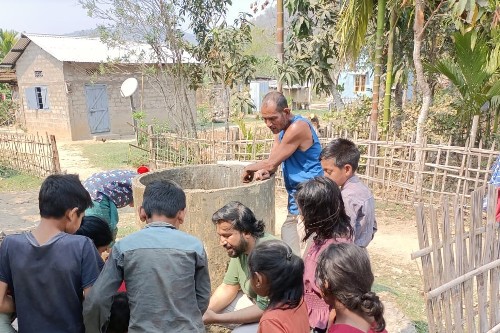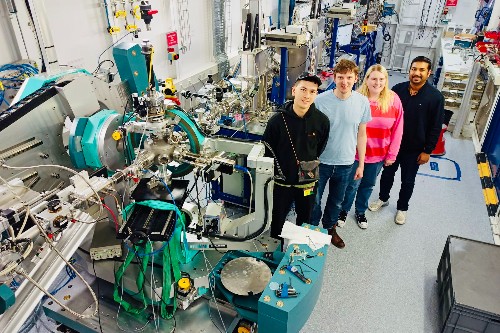
Dr Jagannath Biswakarma (in centre) helping children understand the groundwater quality in his hometown Assam, India. Farishta Yasmin

The research team (left to right) Harry Forrester, Dr James Byrne, Katie O'Neill and Dr Jagannath Biswakarma at XMaS in ESRF, Grenoble in France.Laurence Bouchenoire
A study led by the University of Bristol shedding new light on how arsenic can be made less dangerous to humans has the potential to dramatically improve water and food safety, especially in the Global South.
For the lead researcher it's an academic and personal mission because he witnessed first-hand the constant struggle to find clean, arsenic-free water as a child in India.
Lead author Dr Jagannath Biswakarma, Senior Research Associate at the University's School of Earth Sciences, said: "There are millions of people living in regions affected by arsenic, like I was growing up. This breakthrough could pave the way for safer drinking water and a healthier future."
Arsenic pollution exposure is a huge environmental and public health issue in southern and central Asia and South America, where people depend on groundwater for drinking and farming. The more toxic and mobile form of arsenic, called arsenite, easily seeps into water supplies and can lead to cancers, heart disease and other serious conditions.
Dr Biswakarma said: "I've seen the daily battle for safe drinking water in my hometown Assam. It's very hard to find groundwater sources that aren't contaminated with arsenic, so for me this research hits close to home. It's an opportunity to not only advance science, but also better understand the extent of a problem which has affected so many people in my own community and across the world for many decades."
Scientists previously believed arsenite could only be turned into the less harmful form, called arsenate, with oxygen. But this new study has shown it can still be oxidised, even in the absence of oxygen, with small amounts of iron which act as a catalyst for oxidation.
Dr Biswakarma said: "This study presents a new approach to addressing one of the world's most persistent environmental health crises by showing that naturally occurring iron minerals can help oxidise, lowering the mobility of arsenic, even in low-oxygen conditions."
Study findings revealed that arsenite could be oxidised by green rust sulfate, a source of iron prevalent in low-oxygen conditions, such as groundwater supplies. They also showed this oxidation process is further enhanced with a chemical released by plants and commonly found in soils and groundwater.
"These organic ligands, such a citrate from plant roots, could play a critical role in controlling arsenic mobility and toxicity in natural environments," Dr Biswakarma added.
The implications of this discovery are particularly significant for regions in the Global South facing some of the world's highest levels of arsenic pollution. In countries such as India and Bangladesh, the local geology is rich in iron, and reducing conditions often dominate in groundwater systems, leading to high levels of arsenic contamination. In the Ganges-Brahmaputra-Meghna Delta, which spans Bangladesh and eastern India, millions of people have been exposed to arsenic-contaminated groundwater for decades as the chemical enters the water through natural processes.
Dr Biswakarma said: "Many households rely on tube wells and hand pumps, but these systems do not guarantee access to clean water. The water often cannot be used for drinking or other household tasks due to its toxicity, odour, and discoloration. Additionally, there is an ongoing financial burden associated with obtaining new tube wells or hand pumps. As a result, economically disadvantaged families continue to struggle to find safe water for their daily needs."
Similarly, the Mekong Delta and the Red River Delta, in Vietnam, face ongoing challenges with arsenic pollution, affecting drinking water supplies and agricultural productivity. Rice paddies can become hotspots of arsenic exposure, as the toxic chemical can accumulate in soil and be absorbed by rice plants, posing a further health risk through food consumption.
"The research opens the door for developing new strategies to mitigate arsenic pollution. Understanding the role of iron minerals in arsenic oxidation could lead to innovative approaches to water treatment or soil remediation, using natural processes to convert arsenic into its less harmful form before it enters drinking water supplies," said co-author Molly Matthews, who worked on the paper during her Masters degree in Environmental Geoscience at the University of Bristol.
Identifying the specific form of arsenic in a sample can be challenging. Even a trace amount of oxygen can convert arsenite into arsenate, so it is vital to protect samples from exposure to air. Thanks to funding from the European Synchrotron Radiation Facility (ESRF) the team was able to conduct these complex experiments at its XMaS synchrotron facility, in Grenoble, France.
Co-author Dr James Byrne, Associate Professor of Earth Sciences, added: "Determining arsenic formation at the atomic level using X-ray absorption spectroscopy was crucial for confirming changes to the arsenic oxidation state. The synchrotron therefore played a pivotal role in supporting our findings, which have potentially broad implications for our understanding of water quality."
This work at University of Bristol was supported through a UK Research & Innovation (UKRI) Future Leaders Fellowship (FLF) awarded to Dr James Byrne. Further research is now needed to explore how these findings can be applied in real-world settings.
Dr Biswakarma said: "The whole research team worked tirelessly on this project, putting in 24/7 shifts including over Easter to conduct the experiments in France.
"I genuinely believe, with more work, we can find effective possible solutions and we're already making great inroads to overcoming this big global issue. We're excited to investigate how this process might work in different types of soils and groundwater systems, especially in areas where arsenic contamination is most severe."
Finding bold answers to big questions concerning global challenges is at the heart of the University of Bristol's research. This study cuts across core themes, including advancing equitable and sustainable health, and driving forward social justice.
Paper
'Redox Dynamic Interactions of Arsenic(III) with Green Rust Sulfate in the Presence of Citrate' by Jagannath Biswakarma, Molly Matthews and James M Byrne in Environmental Science & Technology Letters






